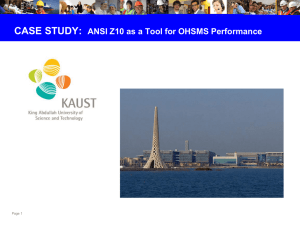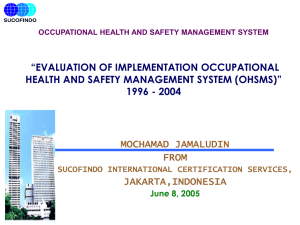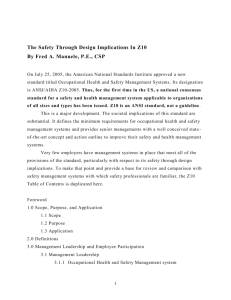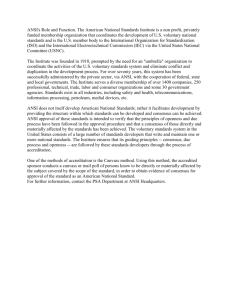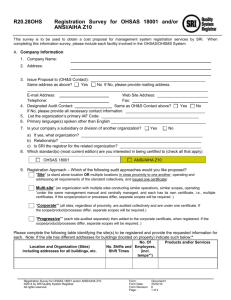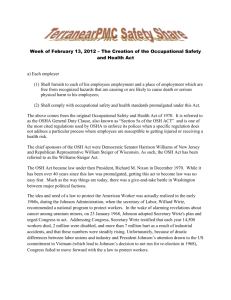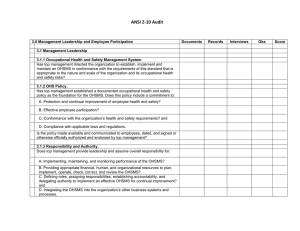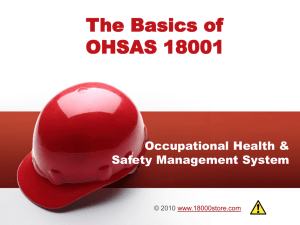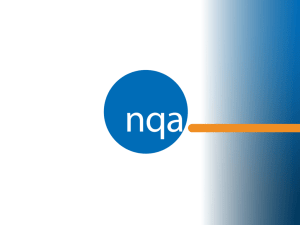Review of the ANSI
advertisement
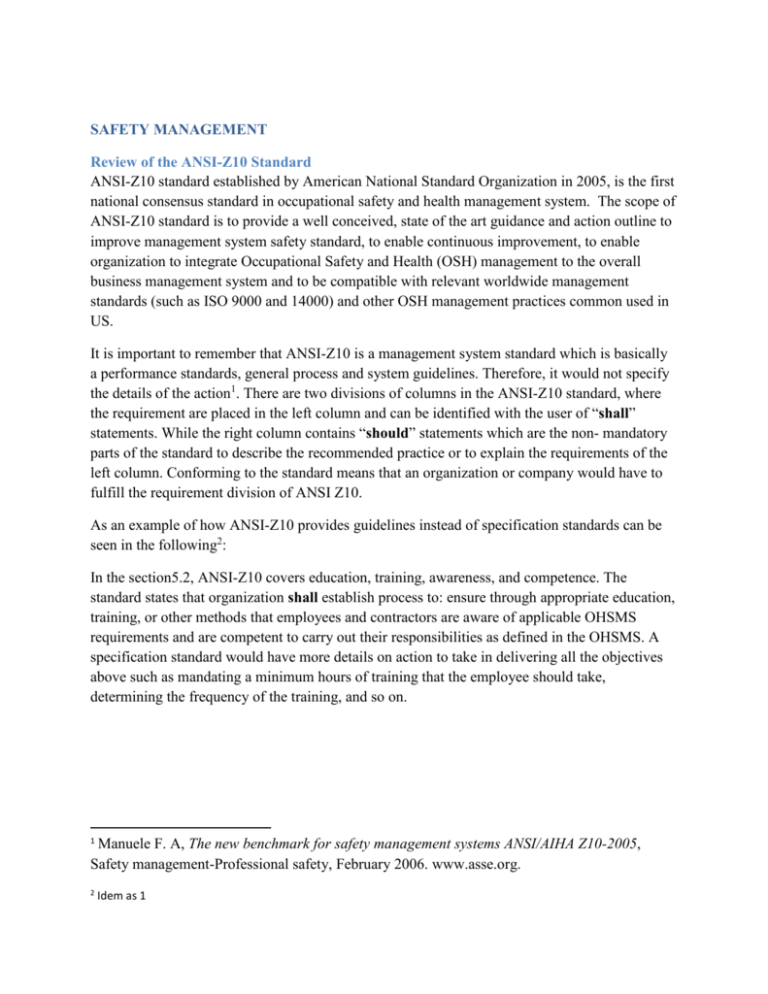
SAFETY MANAGEMENT Review of the ANSI-Z10 Standard ANSI-Z10 standard established by American National Standard Organization in 2005, is the first national consensus standard in occupational safety and health management system. The scope of ANSI-Z10 standard is to provide a well conceived, state of the art guidance and action outline to improve management system safety standard, to enable continuous improvement, to enable organization to integrate Occupational Safety and Health (OSH) management to the overall business management system and to be compatible with relevant worldwide management standards (such as ISO 9000 and 14000) and other OSH management practices common used in US. It is important to remember that ANSI-Z10 is a management system standard which is basically a performance standards, general process and system guidelines. Therefore, it would not specify the details of the action1. There are two divisions of columns in the ANSI-Z10 standard, where the requirement are placed in the left column and can be identified with the user of “shall” statements. While the right column contains “should” statements which are the non- mandatory parts of the standard to describe the recommended practice or to explain the requirements of the left column. Conforming to the standard means that an organization or company would have to fulfill the requirement division of ANSI Z10. As an example of how ANSI-Z10 provides guidelines instead of specification standards can be seen in the following2: In the section5.2, ANSI-Z10 covers education, training, awareness, and competence. The standard states that organization shall establish process to: ensure through appropriate education, training, or other methods that employees and contractors are aware of applicable OHSMS requirements and are competent to carry out their responsibilities as defined in the OHSMS. A specification standard would have more details on action to take in delivering all the objectives above such as mandating a minimum hours of training that the employee should take, determining the frequency of the training, and so on. 1 Manuele F. A, The new benchmark for safety management systems ANSI/AIHA Z10-2005, Safety management-Professional safety, February 2006. www.asse.org. 2 Idem as 1 Overview of the ANSI -Z10 ANSI Z10 standard is developed using Deming’s/ Shewhart’s management Plan-Do-Check-Act framework for improving the workplace environment as well as products. It also combines the principle of relevant Occupational Safety and Health (OSH) management system into American standard compatible with principal national and international standards3. As shown in Figure 1, the OSH management system cycle starts with initial planning process, and then followed by implementation of the management system. Later, the checking process of the performance of these activities is conducted to the previous activities and appropriate actions should be taken in order to make correction or improvement. Next step of the cycle is the management review of the system for suitability, adequacy, and effectiveness against its policy and this standard4. Figure 1. ANSI Z10 OSH Management cycle5 The complete cycle is repeated, resulting in on -going continual improvements in occupational health and safety. 3 Palassis J, Schulte P.A, Geraci, C.L, A New American Management Systems Standard in Occupational Safety and Health – ANSI Z10, Division of Chemical Health and Safety of the American Chemical Society, Elsevier, 2005. 4 Idem as 3 5 Idem as 3 The ultimate goal of ANSI Z10 is the reduction of risks of injuries, illnesses, fatalities, worker’s compensation, cost and lost time. Other benefits that would be expected from complying with this standard are the following6: Improved employee productivity and job satisfaction. Better organization image and employee morale. Fulfillment of legal obligations (compliance with law and regulations). Reduced turnover of personnel. Reduced workdays. Improved employee health status. Improved product quality. Reduction or elimination of property damage due to incident. Reduced business interruption costs. Reduced impact on the environment due to incidents. There seven major points which is outlined in the ANSI Z10 standard. These major points encompassed important elements of OSH7, which are: 1. Scope, Purpose and Application. The standard places an obligation on the HSE professional working to establish management system standards to be familiar with the standard’s provisions. 2. Management of leadership. The ANSI-Z10 standard emphasizes the importance of top management in holding the key role in development, implementation and maintenance of Occupational Health and Safety Management Systems (OHSMS) of a company. The top management is required to lead the OHSMS in an effective way such as active participation of every level of the company is used to achieve the OHSMS targets. The following are major requirements expected from managerial level in compliance with ANSI-Z10 standard: o The management shall direct the organization to establish, implement, and maintain an OHSMS. o The organization’s top management shall establish a documented occupational health and safety policy. o Top management shall provide leadership and assume overall responsibility. More details information on the management leadership and employee participation are provided in the Annexes A, B and C of the standard. 6 Manuele F. A, The new benchmark for safety management systems ANSI/AIHA Z10-2005, Safety management-Professional safety, February 2006. www.asse.org. 7 Idem as 3 3. Employee participation. The organization shall establish and implement processes to ensure effective participation in the OHSMS by its employees at all levels. 4. Planning. In the ANSI-Z10, planning is defined as the process to identify and prioritize OHSMS issues8. Examples of issues considered in the planning are hazards identification, risks assessment, management system deficiencies, and improvement opportunities to continuously implement best practices. 5. Implementation and operation of the Occupational Safety Health Management System. The Occupational Safety Health Management System (OHSMS) operation elements are covered in this section: o Hierarchy of controls. o Design review and Management of change. o Procurement. o Contractors. o Emergency preparedness. o Education, Training and Awareness. o Communications. o Documentation & record control process. Hierarchy of controls sets companies to take classic risk reduction steps through elimination, substitution of less hazardous materials/process/operation/equipment, engineering controls, warnings, administrative controls and the use of personal protective equipment (PPE). The documentation and record control process are designed to comply with the ISO 9000 and 14001 standards. 6. Evaluation and corrective action. Evaluation and corrective action covers Monitoring and Measurement Incident investigations Audits Corrective and preventive actions Feedback to the planning process For every deficiency found after evaluation, direct corrective measure is recommended to be taken immediately. 8 Idem as 1 7. Management review. The management review section is divided in two points of review, which are: (1) Management review process and (2) Management review outcomes and follow-up. According to ANSI-Z10, a management review of OSHMS should be conducted at least once every year to ensure that proper actions are taken following evaluation and improvements are continuously done.
